|
Extra Large Dog BreedIf you prefer a big dog over a small dog, but think an extra large dog breed is too big, think again. Extra large dogs may take up more space, but they can be easier to take care of than a large or medium sized dog. Start their training early if possible, or as soon as you adopt, so they are easier to manage. Sadly, these extra large dog breeds have a shorter lifespan than other dogs. You might think that these extra large breed dogs are tough, but you'd be surprised. My sister had a Great Dane once and left me in the house with him when she left to do some errands. Oh my goodness; what a big baby! He whined and whined for his "mommy" as soon as she left. Most of the extra large dog breed dogs are gentle and make wonderful family pets. Let's look at some of these dogs in the extra large dog breed category. You'll find they're large on love and loyalty too.
The Great Dane - the "gentle giant"The Great Dane is one of the largest of the extra large dog breed dogs; a male may weigh up to 200 pounds! As with most extra large dogs, they are gentle and good natured. Male Height:27 to 34 inches / Male Weight:120 to 200 pounds Female Height:25 to 27 inches / Female Weight:100 to 130 pounds The Great Dane can have several colorations including Harlequin (white with black irregular patches), solid black, solid white, mantle (black blanket with white markings), fawn with black points and solid blue. The Great Dane has a short, dense and fine coat. Great Danes are a regal looking dog, although they may appear intimidating to those that are unfamiliar with the breed. They are solidly built, and though a bit lanky looking, are very athletic. The dog is calm and reserved, especially around strangers. The Great Dane remains very playful well into its adult years. They are moderately active and long walks, hiking or long off leash times are better for the breed than sort, intense periods of exercise. The Great Dane is an amazingly adaptable large breed of dog that can tolerate smaller living spaces such as apartments provided they have lots of regular outdoor exercise. They will also do well in a house with a medium to large sized yard. The Great Dane is loyal to its family and will be a strong protector which makes them a natural watchdog. It order for the Great Dane to be well socialized, they need lots of time with other dogs. Off-leash dog parks are a great place for them to meet other dogs and get proper exercise. Or if you're a roller blader, let him pull you around. You better be good on those blades though! Due to their great size, hip dysplasia is common. They may suffer from skin allergies, and are more prone to heart conditions leading to possible heart attacks and respiratory problems. Their life span is only six to eight years.
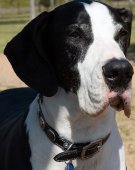
Newfoundland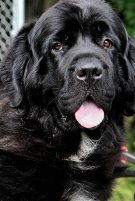
My dog is part Newfoundland, part Labrador, so of course I must include the Newfoundland as one of the extra large dog breeds I discuss! Besides, they are a wonderful, sweet dog. Male Height: 27 to 29 inches / Male weight:130 to 150 pounds Female Height: 25 to 27 inches / Female Weight:100 to 120 pounds Newfoundland colors are black, brown, gray, and white and black. The head is massive, with a broad skull. Newfoundlands are supposed to be master long-distance swimmers (not my dog) and have true lifesaving instincts in the water. They are large and strong, possessing a heavy coat to protect him from icy waters. (She does prefer cold weather over hot, and she adores plowing through the snow). With their heavy coat, heat is bothersome so they definitely need shade or to be inside if it's too warm. Newfoundlands are known for their sweetness; this is the most important single characteristic of the breed. I agree! She's also very devoted, another Newf characteristic. This sweet disposition makes them a good family dog. Our dog, Sydney is very easy going and gentle with children although she does tend to get right up into their faces, which is fine if a child is used to dogs, but can be a bit overwhelming to children who haven't grown up around them. Although they appear somewhat docile, Newfoundlands are an active dog and will need daily exercise. Regular brushing is important to maintain their thick fur and undercoat. Newfs are also intelligent and easily trained. Train when they are young while they are easier to control. Newfs shed and drool a lot, so if either bothers you, this dog won't be the right extras large dog breed for you. Hip dysplasia and heart defects are common problems with Newfoundlands, however; a responsible breeder will not continue to breed dogs with known defects, so make sure you find a reputable breeder if you plan on getting a purebred Newfoundland. A good breeder will guarantee against these defects. Lifespan of the Newfoundland is 9 - 15 years / Average 10 years
A Newfoundland Tribute The epitaph written by Lord Byron inscribed on the grave of his Newfoundland:
Near this spot
are deposited the remains of one
who possessed beauty without vanity
strength without insolence
courage without ferocity
and all the virtues of man without his vices.
This praise which would be
unmeaning flattery
if inscribed over human ashes
is but a just tribute to the memory of
Boatswain, a dog
who was born at Newfoundland, May 1803,
and died at Newstead Abbey,
November 18, 1808.
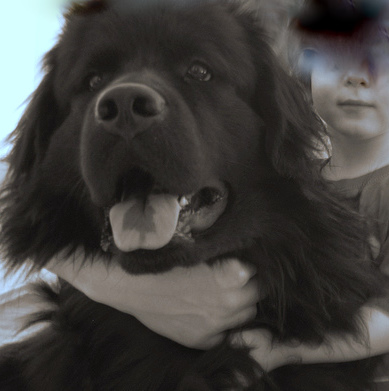
St. Bernard - "the dog that rescues people"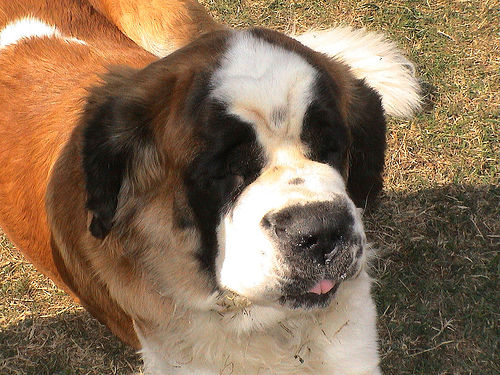
Male Height: 28 to 30 inches / Male Weight: 140 to 180 pounds. Female Height: 26 to 28 inches / Female Weight: 120 to 140 pounds. Another of the extra large dog breed dogs is the St Bernard. It may have either a long or short coat and can be either smooth or slightly wavy. Both coats are dense and tough, and shed profusely at least once a year. Saints are always some combination of tan and white or brindle and white. The tan can range from lemony-brown to deep red. They are big droolers, so if that disgusts you, this breed won't work for you. Or, just keep a drool rag available at all times! The breed needs a moderate amount of outdoor exercise and tends to be quiet in the house after outgrowing the puppy stage. Be sure to train early as a rambunctious and giant St Bernard can wreak havoc on your home. Saints can be easy to train because they like to please. The St Bernard is a gentle family companion, excellent with children, and has a big heart and friendly demeanor. As with other extra large breed dogs, St Bernards may suffer from joint problems such as hip dysplasia. Once again, find a reputable breeder if looking for a purebred. Saint Bernards have lifespans of 7-11 years.
Bullmastiff - "the Gamekeeper's Night Dog"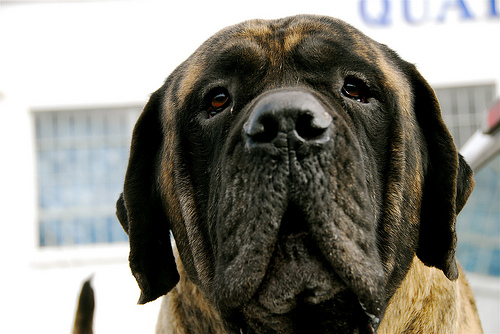
Male Height: 25 to 27 inches / Male Weight: 110 to 130 pounds Female Height: 24 to 26 inches / Female Weight: 100 to 120 pounds I think they should call this extra large dog breed the Bull Massive! I am always amazed when I see a Bullmastiff. They just seem SO big. Their hair coat is short, smooth, and dense and most often red, fawn or brindle (dark streaks or flecks on a gray or tawny background). They have a large broad wrinkled head and massive body. The Bullmastiff is loyal to family and quite docile and gentle. The breed is known as intelligent, obedient, brave and affectionate. He will naturally assume the role of family guard and protector. Until recently, the Bullmastiff was primarily a guard and watchdog. Although large, the breed remains both agile and active. The breed does not require much exercise or grooming, and can live happily in a house or apartment. Training should begin early, as the Bullmastiff may not be the easiest to train due to his independent thinking. Prone to hip dysplasia, cancer, eyelid problems and bloat, (the stomach fills with air to due an excess of gas, and organs can become twisted). This can be life threatening, so take your dog to the vet IMMEDIATELY if bloat is suspected. Life expectancy is 8 to 10 years.
Bernese Mountain Dog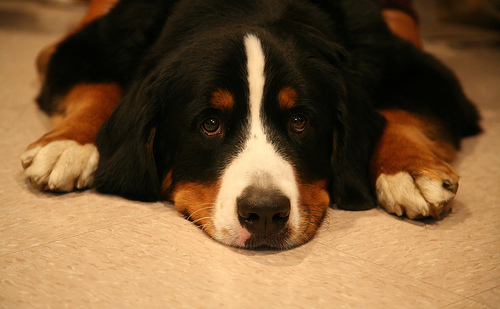
Male Height: 24 to 28 inches / Male Weight: 85 to 110 pounds Female Height: 23 to 27 inches / Female Weight: 80 to 105 pounds I absolutely love the looks of this adorable dog! Besides being beautiful to look at, they are sweet and gentle. The Bernese mountain dog has a short, massive head, dark eyes and V-shaped ears. The tail is covered with long hair and the body is strong and muscular. The coat is black, brown, and white with double thickness. The coat is shiny, smooth, long and wavy. The Bernese mountain dog is intelligent, sweet and loving, usually outgoing, and loves people. This extra large dog breed needs to be socialized and should begin basic obedience training at a very young age. This dog prefers cooler climates. When exposed to hot and humid environments, he may be prone to overheating. Make sure he has lots of shade and water, or bring inside if it's cooler. An interesting trait of the Bernese Mountain dog is that it becomes very attached to its family, and after 18 months of age has trouble adjusting to a new family. If you find a one of these dogs needing adopting, you may need to spend a little extra time trying to bond with them. It well be well worth it, as animals understand love and devotion. Health issues include hip and elbow dysplasia, bloat and problems with the eye and eyelid, including cataract. Keep a close eye on this dog in the heat as heat stroke is common. The life span of the Bernese mountain dog is approximately 8 to 10 years. Extra Large Dog Breed RescueIf you are interested in adopting an extra large dog of a particular breed, there are organizations that deal specifically with pure breed rescue. I can't stress the importance of researching what type of dog you want to adopt. Many dog owners are still unprepared for the commitment of dog ownership, especially of an extra large dog breed and these dogs end up unwanted and in shelters. Unforeseen situations can occur such as a serious illness, but a majority of reasons dogs are in need of rescue, should have been anticipated and avoided - family members who have allergies, maintenance costs, just the time it takes to exercise and care for a dog. Following is a list of rescue organizations for the extra large dog breed purebreds that are discussed above. St. Bernard Rescue American Bullmastiff Association Rescue The Bernese Mountain Dog Rescue The American Kennel Club has a directory of all pure breed rescue organizations. Return from Extra Large Dog Breed to Choosing a Dog
|





